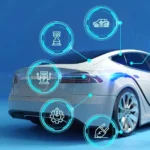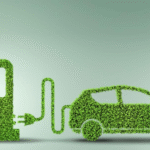Smarter EV Lending Starts with Smarter Data! – With electric vehicles (EVs) growing rapidly worldwide, financial institutions are trying to navigate the opportunities and challenges of lending on EVs. Increased consumer demand is encouraging lenders to be more active in EV lending, however, EVs represent a new customer cohort, and their ownership and resale experiences are at least somewhat different from traditional internal combustion engine (ICE) vehicles. Not to mention, lenders may find value in adopting EV lending practices that are quite different from those in the current ICE lending practice as a result. Lending has been built on the changing technologies in ICE vehicles, and now EVs bring a unique and fresh opportunity, but also complications. This is why smarter EV lending starts with smarter data.

Using the best data available, in real-time and that is as relevant as possible, allows lenders to create relevant loan offerings, assess risk more accurately, and build trust and less frustration for consumers, and when lenders re-engage as consumers explore EVs’ cost of ownership and adoption and return to electric mobility. In this article, we will look at how the best data is changing EV lending, what data points are most important, and how lenders can move quickly to be competitive.
Why EV Lending is different – A data-driven approach is required
EVs represent a major change, not just in technology but also in the process by which consumers now buy and finance vehicles. In contrast to traditional vehicles, EVs:
- Have greater capital costs, however, lower total cost of ownership (TCO)
- Today, have various federal, state, and local incentives that change variable frequency
- Depreciate differently than ICE vehicles
- Utilize the charging infrastructure, which now has a pathway to both usability and resale
- Can receive OTA updates that can improve or deteriorate their resale and/or value post-purchase.
These factors make underwriting and loan structuring more challenging. Without granular, accurate, and timely data, lenders run the risk of overestimating vehicle value, underestimating risk, and extending terms that are less attractive to consumers. A data-driven solution can help fill that gap.
Once lenders can access smarter data, such as real-time market values, total cost of ownership (TCO) estimates, charging patterns, and incentive eligibility, they will have real data to guide their decisions and ultimately provide better, fairer, and more competitive loan and lease terms.
What Is Smarter Data in EV Lending?
Smarter data within EV lending means high-quality, relevant, and usable information that is broader than simple credit scores and loan-to-value (LTV) numbers. It means information about the following:
Depreciation Trends Specific to EVs – Data that informs lenders on the current, real-time depreciation of different makes and models of EVs, as a function of range, battery status, and marketplace demand.
Best Available Incentive and Tax Credit Eligibility – Dynamic data on federal, state, and DDO utility incentives, as applied to each vehicle and customer profile.
Charging and Related Infrastructure – Data on the customer’s accessibility to home or public charging, which significantly impacts their EV satisfaction and adoption, as well as the potential maturity value of the EV.
Battery Health and Warranty Coverage – Battery lifecycle is arguably the single most important component of resale value and owner satisfaction. Access to this data lowers lender risk.
Total Cost of Ownership (TCO) – Taking into consideration estimated fuel savings, maintenance costs, and insurance cost differences between electric vehicles (EVs) and internal combustion engine (ICE) vehicles.
Environmental Impact Metrics – A few lenders, particularly those with ESG mandates, may take into account the emission reductions associated with financing an electric vehicle.
By pooling this information together, lenders can better tailor loan terms to individual borrowers and more accurately price risk for the purchase of a specific EV.
Benefits of Smarter Data for Financial Institutions
Here is how smarter data benefits EV lending for financial institutions –
Risk mitigation Improved risk assessment
By providing data-driven insights into the long-term value of EVs, lenders will have a better understanding of the risk of loan default and the overall stability of their portfolio.
Customizable Lending Products: Personalized lending products
Lenders can provide personalized lending products that include the knowledge of the individual customer’s needs, what kind of vehicle they want, customized interest rates, flexible length of terms, and bundled incentives.
Higher approval rates
Smarter, data-driven lending allows lenders to use more inclusive and alternative underwriting models that can increase access to EVs for a greater audience, including applicants with thin credit files.
Better customer relationships
When borrowers feel as if their lender understands the nuances of owning an EV and is actively supporting green choices, both borrower satisfaction and loyalty to that lender increase.
Competitive advantage
Lenders are establishing themselves as early adopters of a smarter EV lending model, giving them a first mover advantage and the ability to gain substantial market share before the competition catches up.
The Significance of Artificial Intelligence and Machine Learning in EV Lending
Artificial intelligence and machine learning (AI/ML) are pivotal in turning lots of data into actionable insight. By leveraging predictive analytics and real-time analytics, AI can –
- Find geo- and model-specific trends in EV resale value.
- Predict default risk based on usage trends.
- Provide recommendations for custom loan structures based on EV TCO.
- Automate eligibility checks for federal and local incentives.
The result is expedient, intelligent, and more accurate loan processing, benefiting both efficiency and customer experience.
Developing a Future-Proof EV Lending Platform
Now that you have access to smarter data, lenders will need to continue to modernize their technical architecture. This includes –
- Integrating data points using 3rd party data providers for EV-specific market and incentive data.
- Implementing cloud-based loan origination platforms that permit modular ingestion of data.
- Using APIs to facilitate real-time updates in vehicle value, tax credits, and charging infrastructure.
- Training underwriting teams to understand the implications of EV data insights relative to risk, given variations within EVs
This transition represents investment, but the return on investment (ROI) over time will be significant; sustainable portfolios, growing profits, and leadership in an emerging green finance marketplace.
Conclusion
Electric vehicles represent the future of mobility, and therefore, lenders must proactively adapt to this shift. To develop a more intelligent EV lending approach, it begins with more intelligent data, and the lenders that can leverage it properly will gain the lead in a competitive, high-growth sector.
By rethinking vehicle lending with smarter data as the basis, financial institutions will be able to build better portfolios, grow their relationship with customers, and hopefully contribute in some way to accelerating the world’s move to clean energy.
FAQs
Why is EV lending different from traditional auto lending?
Understanding EV lending is complicated by nuances such as battery health, incentives, and depreciation models, so time-tested ICE lending models are less useful. Smart data ultimately will provide lenders a better view of the consideration of the unique variables.
What data is most important for making an EV lending decision?
The most useful data includes battery health, driving range, depreciation pattern, acceptance of incentives, and TCO. All of these data points help lenders understand, over the life of the vehicle, the true value and risk of an EV.
How can lenders access more intelligent EV data?
Lenders will be able to partner with specialized data providers, use EV-specific APIs, and take advantage of analytics and reporting tools that provide real-time data within their loan origination system (LOS).
What are the benefits for borrowers in a smarter, data-driven EV lending model?
Higher transparency, faster approvals, reduced interest rates, and more individualized loan terms could all benefit borrowers and make EV ownership more secure and fulfilling.








